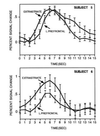Detection of cortical activation during averaged single trials of a cognitive task using functional magnetic resonance imaging
- PMID: 8962149
- PMCID: PMC26230
- DOI: 10.1073/pnas.93.25.14878
Detection of cortical activation during averaged single trials of a cognitive task using functional magnetic resonance imaging
Abstract
Functional neuroimaging studies in human subjects using positron emission tomography or functional magnetic resonance imaging (fMRI) are typically conducted by collecting data over extended time periods that contain many similar trials of a task. Here methods for acquiring fMRI data from single trials of a cognitive task are reported. In experiment one, whole brain fMRI was used to reliably detect single-trial responses in a prefrontal region within single subjects. In experiment two, higher temporal sampling of a more limited spatial field was used to measure temporal offsets between regions. Activation maps produced solely from the single-trial data were comparable to those produced from blocked runs. These findings suggest that single-trial paradigms will be able to exploit the high temporal resolution of fMRI. Such paradigms will provide experimental flexibility and time-resolved data for individual brain regions on a trial-by-trial basis.
Figures




Comment in
-
Improving functional imaging techniques: the dream of a single image for a single mental event.Proc Natl Acad Sci U S A. 1996 Dec 10;93(25):14302-3. doi: 10.1073/pnas.93.25.14302. Proc Natl Acad Sci U S A. 1996. PMID: 8962042 Free PMC article. No abstract available.
References
-
- Deyoe E A, Bandettini P, Neitz J, Miller D, Winans P. Neurosci Methods. 1994;15:171–187. - PubMed
-
- Raichle M E. In: The Handbook of Physiology. Plum F, Mountcastle V, editors. Vol. 5. Bethesda, MD: Am. Physiol. Assoc.; 1987. pp. 643–674.
-
- Cohen M S, Weisskoff R M. Magn Reson Imaging. 1991;9:1–37. - PubMed
-
- Hinke R M, Hu X, Stillman A E, Kim S-G, Merkle H, Salmi R, Ugurbil K. NeuroReport. 1993;14:675–678. - PubMed
-
- Binder J R, Rao S M, Hammeke T A, Frost J A, Bandettini P A, Jesmanowicz A, Hyde J S. Arch Neurol. 1995;52:593–601. - PubMed
Publication types
MeSH terms
Grants and funding
LinkOut - more resources
Full Text Sources
Other Literature Sources

